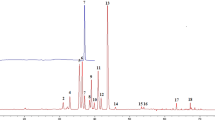Abstract
Angelica sinensis (Oliv.) Diels (“Danggui” in Chinese) is one of the most commonly used traditional Chinese medicines. It has been used to invigorate blood circulation for the treatment of anemia, hypertension, chronic bronchitis, asthma, rheumatism, and cardiovascular diseases. There are a number of A. sinensis-derived dietary supplements in the US markets. However, no study have been conducted to investigate the quality of these dietary supplements. In this paper, high-performance liquid chromatographic and flow-injection mass spectrometric fingerprints were both evaluated to assess the consistency of A. sinensis-derived dietary supplements. Similarity analysis was carried out on the high-performance liquid chromatographic (HPLC) fingerprints. Meanwhile, principal component analysis (PCA) was performed on the data obtained from flow-injection mass spectrometric (FIMS) fingerprints, which can analyze each sample in 2 min, compared with 30 min required for the chromatographic fingerprint. Both methods show significant chemical differences between samples that may be due to differences in growing locations, growing conditions, harvesting times, and/or botanical processing. The loading plots obtained from PCA singled out the discriminatory ions that were responsible for chemical differences of A. sinensis-derived dietary supplements.

In the present study, HPLC and flow-injection mass spectrometric fingerprints as well as chemometrics were applied to assess the consistency of A. sinensis-derived dietary supplements from U.S. markets in order to understand the variability of the products and to provide useful information with customers.







Similar content being viewed by others
References
Council NP (2005) Pharmacopoeia of China. Chemical Industry Press, Beijing
Yim TK, Wu WK, Pak WF, Mak DH, Liang SM, Ko KM (2000) Myocardial protection against ischaemiareperfusior injury by a Polygonum multiflorum extract supplemented “Dang-Gui decoction for enriching blood”, a compound formulation, ex vivo. Phytother Res 14:195–199
Liu CX, Xiao PG (1993) An introduction to Chinese meteria medica. Peking Union Medical College and Beijing Medical University Press, Beijing
Zhou X, Zhao Y, Lei PH, Cai ZW, Liu H (2010) Chromatographic fingerprint study on Evodia rutaecarpa (Juss.) Benth by HPLC/DAD/ESI-MSn technique. J Sep Sci 33:2258–2265
Cai M, Zhou Y, Gesang SL, Bianba C, Ding LS (2006) Chemical fingerprint analysis of rhizomes of Gymnadenia conopsea by HPLC-DAD-MSn. J Chromatogr B 844:301–307
Xu LN, Han X, Qi Y, Xu YW, Yin LH, Peng JY, Liu KX, Sun CK (2009) Multiple compounds determination and fingerprint analysis of Lidanpaishi tablet and keli by high-performance liquid chromatography. Anal Chim Acta 633:136–148
World Health Organization (1991) Guidelines for the assessment of herbal medicine. World Health Organization, Munich
Wang S, Ma HQ, Sun YJ, Qiao CD, Shao SJ, Jiang SX (2007) Fingerprint quality control of A. sinensis by high-performance liquid chromatography coupled with discriminant analysis. Talanta 72:434–436
Lu GH, Chan K, Liang YZ, Leung K, Chan CL, Jiang ZH, Zhao ZZ (2005) Development of high-performance liquid chromatographic fingerprints for distinguishing Chinese angelica from related Umbelliferae herbs. J Chromatogr A 1073:383–392
Chen Y, Zhu SB, Xie MY, Nie SP, Liu W, Li C, Gong XF, Wang YX (2008) Quality control and original discrimination of Ganoderma lucidum based on high-performance liquid chromatographic fingerprints and combined chemometrics methods. Anal Chim Acta 623:146–156
Mardia KV, Kent JT, Bibby JM (1979) Multivariate analysis. Academic, New York
Vega M, Pardo R, Barrado E, Deban L (1998) Assesment of seasonal and polluting effects on the quality of river water by exploratory data analysis. Water Res 32:3581
Kannel PR, Lee S, Kanel SR, Khan SP (2007) Chemometric application in classification and assessment of monitoring locations of an urban river system. Anal Chim Acta 582:390–399
Sun JH, Chen P (2011) A flow-injection mass spectrometry fingerprinting method for authentication and quality assessment of Scutellaria lateriflora-based dietary supplements. Anal Bioanal Chem 401:1577–1584
Lin LZ, He XG, Lian LZ, King W, Elliott J (1998) Liquid chromatographic–electrospray mass spectrometric study of the phthalides of A. sinensis and chemical changes of Z-ligustilide. J Chromatogr A 810:71–79
Yang F, Xiao YS, Zhang FF, Xue XY, Xu Q, Liang XM (2006) High performance liquid chromatography-mass spectrometry analysis of radix Angelica sciensis. Acta Phar Sinica 41:1078–1083
Lu XH, Zhang JJ, Zhang XX, Liang H, Zhao YY (2008) Study on biligustilides from Angelica sinensis. China J Chin Mater Med 33:2196–2201
Lao SC, Li SP, Kan KKW, Li P, Wan JB, Wang YT, Dong TTX, Tsim KWK (2004) Identification and quantification of 13 components in Angelica sinensis (Danggui) by gas chromatography–mass spectrometry coupled with pressurized liquid extraction. Anal Chim Acta 526:131–137
Xue WX, Hua YL, Guo YS, Ji P, Wu HY, Wei YM (2012) Changes of composition in different parts of Angelicae sinensis based on geoherbs. J Gansu Agric Univ 47(1):149–154
Lu XH, Zhang JJ, Liang H, Zhao YY (2004) Chemical constituents of Angelica sinensis. J Chin Pharm Sci 13(1):1–3
Song QY, Fu YB, Liu J, Zheng D, Han L, Huang XS (2011) Chemical constituents from Angelica sinensis. Chin Tradit Herbal Drugs 42(10):1900–1904
Lou L, Zhu DN, Yan YQ (2005) SFE-CO2 constituents of simplified formula of Danggui Shaoyao powder in the prevention and treatment of vascular dementia. Chin Tradit Pat Med 27(11):1251–1254
Acknowledgment
This research is supported by the Agricultural Research Service of the US Department of Agriculture and an Interagency Agreement with the Office of Dietary Supplements of the National Institutes of Health.
Author information
Authors and Affiliations
Corresponding author
Additional information
Published in the topical collection Functional Foods and Dietary Supplements with guest editors Melissa M. Phillips and Catherine A. Rimmer.
Rights and permissions
About this article
Cite this article
Zhao, Y., Sun, J., Yu, L.L. et al. Chromatographic and mass spectrometric fingerprinting analyses of Angelica sinensis (Oliv.) Diels-derived dietary supplements. Anal Bioanal Chem 405, 4477–4485 (2013). https://doi.org/10.1007/s00216-012-6668-1
Received:
Revised:
Accepted:
Published:
Issue Date:
DOI: https://doi.org/10.1007/s00216-012-6668-1




